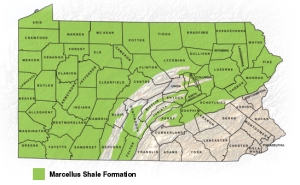[vc_row animation=””][vc_column width=”1/1″][vc_column_text]Last week, we featured the #AskCabot question, “How old is the Marcellus Shale.” As most of you know, we at Cabot Oil & Gas Corporation love the Marcellus Shale, so we answered promptly with “The Marcellus Shale was formed 390 million years ago.” But we couldn’t contain our passion for the stuff to just that tweet – today we’ll dive into not only how old the Shale is, but also some fun facts you might not have known before.[/vc_column_text][/vc_column][/vc_row][vc_row animation=””][vc_column width=”1/2″][vc_single_image css_animation=”” image=”995″ border_color=”” img_link_large=”” link=”http://cabotsusq.files.wordpress.com/2012/07/capture2.png” img_link_target=”_self” img_size=”medium”][/vc_column][vc_column width=”1/2″] What is the Marcellus Shale?[/vc_column][/vc_row][vc_row animation=””][vc_column width=”1/1″][vc_column_text]We wrote in a Mulligan insert that the Marcellus Shale Formation is the largest source of domestic natural gas discovered in the United States and could very well become the second largest natural gas field in the world. Extending through parts of Pennsylvania, New York, West Virginia and Ohio, the Marcellus field was formed 390 million years ago from an abundance of plant and marine life. As this organic material decomposed, it became trapped as natural gas and buried deep below the earth in fissures, cracks and pores of the forming shale. Today, this natural gas is not only useful, but it also creates value for the local community.[/vc_column_text][/vc_column][/vc_row][vc_row animation=””][vc_column width=”1/1″][vc_column_text]Why the Marcellus Shale is so extraordinary: [/vc_column_text][/vc_column][/vc_row][vc_row animation=””][vc_column width=”1/1″][vc_column_text]In Susquehanna County, Cabot has already created hundreds of local jobs and invested a total of $1 billion. This includes $43 million in royalties paid directly to local landowners and $10 million spent on road construction and maintenance. In the years to come, Cabot will focus on increasing America’s clean energy production, creating more local jobs, supporting more local industries and investing more in local education.[/vc_column_text][/vc_column][/vc_row][vc_row animation=””][vc_column width=”1/1″][vc_column_text]A recent study by Penn State University shows that the natural gas industry is already having a dramatic affect on the Pennsylvania economy that will continue for decades to come. As a matter of fact, the natural gas industry generated 88,000 new jobs in Pennsylvania during 2010. And it anticipates adding over 100,000 jobs and investing more than $11 billion in the state’s economy this year alone. Now that’s progress toward the kind of future we can all believe in. Fast facts about Marcellus Shale: [/vc_column_text][/vc_column][/vc_row][vc_row animation=””][vc_column width=”1/1″][vc_column_text](These facts come courtesy of the Marcellus Shale Coalition, Thanks MSC!)
What is the Marcellus Shale?[/vc_column][/vc_row][vc_row animation=””][vc_column width=”1/1″][vc_column_text]We wrote in a Mulligan insert that the Marcellus Shale Formation is the largest source of domestic natural gas discovered in the United States and could very well become the second largest natural gas field in the world. Extending through parts of Pennsylvania, New York, West Virginia and Ohio, the Marcellus field was formed 390 million years ago from an abundance of plant and marine life. As this organic material decomposed, it became trapped as natural gas and buried deep below the earth in fissures, cracks and pores of the forming shale. Today, this natural gas is not only useful, but it also creates value for the local community.[/vc_column_text][/vc_column][/vc_row][vc_row animation=””][vc_column width=”1/1″][vc_column_text]Why the Marcellus Shale is so extraordinary: [/vc_column_text][/vc_column][/vc_row][vc_row animation=””][vc_column width=”1/1″][vc_column_text]In Susquehanna County, Cabot has already created hundreds of local jobs and invested a total of $1 billion. This includes $43 million in royalties paid directly to local landowners and $10 million spent on road construction and maintenance. In the years to come, Cabot will focus on increasing America’s clean energy production, creating more local jobs, supporting more local industries and investing more in local education.[/vc_column_text][/vc_column][/vc_row][vc_row animation=””][vc_column width=”1/1″][vc_column_text]A recent study by Penn State University shows that the natural gas industry is already having a dramatic affect on the Pennsylvania economy that will continue for decades to come. As a matter of fact, the natural gas industry generated 88,000 new jobs in Pennsylvania during 2010. And it anticipates adding over 100,000 jobs and investing more than $11 billion in the state’s economy this year alone. Now that’s progress toward the kind of future we can all believe in. Fast facts about Marcellus Shale: [/vc_column_text][/vc_column][/vc_row][vc_row animation=””][vc_column width=”1/1″][vc_column_text](These facts come courtesy of the Marcellus Shale Coalition, Thanks MSC!)
- The Marcellus is about a mile below the surface, and natural gas is usually extracted by drilling horizontally through the shale.
- To protect groundwater resources, Marcellus wells must be encased with multiple layers of steel and concrete—one of many regulations in place to protect our environment.
- More than 70 percent of all Marcellus-related jobs are filled by Pennsylvanians, while 93 percent are filled by residents from the five-state Marcellus region.
- Pennsylvania counties with major Marcellus production experience higher sales tax collections and lower unemployment.
- Natural gas does far more than heat your home and help to cook your food. It’s a key component of many common household products as well.
For more information about Marcellus Shale, visit Penn State University’s Marcellus Center website or the Marcellus Shale Coalition site. Remember that today is an #AskCabot Thursday. We’ll take your questions, tagged with #AskCabot all day to our Twitter account or to our #AskCabot webpage. If you have a good question, you could be featured in next week’s recap.[/vc_column_text][/vc_column][/vc_row][vc_row animation=””][vc_column width=”1/1″][vc_single_image css_animation=”” image=”1002″ border_color=”” img_link_large=”” link=”http://cabotsusq.files.wordpress.com/2012/07/marcellus-map_usgs_5001.jpg” img_link_target=”_self” img_size=”medium”][/vc_column][/vc_row]